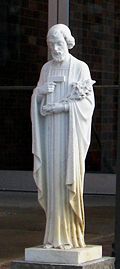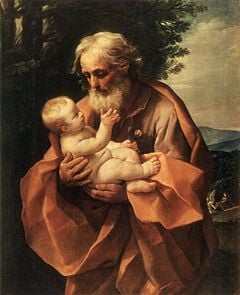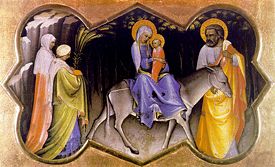Joseph (father of Jesus)
| Saint Joseph | |
|---|---|
St Joseph with the Infant Jesus by Guido Reni | |
| Foster-father of the Lord; the Betrothed | |
| Born | Unknown date B.C. |
| Died | Prior to the Passion (traditional) in Nazareth (traditional) |
| Venerated in | All Christianity |
| Feast | March 19 (Roman Catholicism), the Sunday after the Nativity of the Lord (Eastern Orthodoxy) |
| Attributes | Carpenter's square or tools, the infant Jesus,
staff with blossoms. |
| Patronage | The Universal Church, workers, against doubt and hesitation and of a happy death. Many others; see [5] |
Joseph "of the House of David" (also Saint Joseph, Joseph the Betrothed, Joseph of Nazareth, and Joseph the Worker) was, according to Christian Gospel accounts and tradition, the husband of Mary[1] and the legal father of Jesus of Nazareth,[2] although Christian faith tradition holds that Joseph did not physically beget Jesus, but that Mary had conceived him through divine means (see Virgin Birth).[3][4] Little else is known of Joseph except that he was apparently a skilled craftsman (often held to have been a carpenter) and for many years lived in the town of Nazareth. Joseph's death is not recorded; he is thought to have still been alive when Jesus was around 12 years old, due to scriptural mention,[5] but the lack of any mention of him in the Biblical accounts of Jesus' adult ministry (some 18 years later) is often taken to imply that he had died before then.
A notable fact about Joseph is that not one single word spoken by him is quoted anywhere in any of the Four Gospels.
In the Roman Catholic and other traditions, he is the patron saint of workers and has several feast days (see Saint Joseph's Day). Saint Joseph was also declared to be the patron saint and protector of the universal Catholic Church (along with Saint Peter) by Pope Pius IX in 1870, and is the patron of several countries and regions.
Gospel accounts
Joseph takes an active role only the Gospel of Matthew and the Gospel of Luke. He is not mentioned in [[Gospel of Mark|Mark[[, and in John his name is mentioned only as the surname of Jesus, as in "Is this not Jesus, the son of Joseph, whose father and mother we know?" (John 6:42)
Matthew begins (Matthew 1:1-16) with a genealogy beginning with Abraham and then tracing Jesus' lineage through King David down through the generation until Joseph. The genealogy is paradoxical in that it proves Jesus' Davidic lineage through Jesus, and yet Matthew claims that Joseph was not actually Jesus' father. It goes on to explain that Joseph's betrothed wife,[6] Mary, was found to be pregnant before Joseph had intercourse with her. A righteous man, he did not wish to expose her to public disgrace or punishment, but did intend to divorce her. An angel appeared to him, however, and instructed Joseph to take Mary as his wife, because the child in her womb as conceived by the Holy Spirit. Joseph complied and married her, but had not sexual relations with her until after she gave birth. In accordance with the angel's instruction, he gave the child the name Yeshua (Jesus), meaning "the Lord saves."
Non-Gospel accounts and anecdotes
Jesus is described as working side by side with Joseph in Joseph's carpenter shop at Nazareth, and sometimes he stayed with Joseph while the latter worked in Christian stories of Jesus' early life. Joseph made an important decision when he heard that Mary was pregnant before their arranged marriage. Instead of having townspeople throw rocks at Mary, Joseph took her away and protected her. In some Catholic traditions (including Roman Catholic), Joseph is described as dying "in the arms of Jesus and Mary." [7] [8]
In the canonical Gospel accounts Jesus is described as being the brother of James, Joses (Matthew has the spelling: Joseph, Mark has Joses), Judas, and Simon, and of sisters whose names however are not mentioned (Matthew 13:55, Mark 6:3). A tradition at least as early as the second century, still current in Eastern Orthodoxy, explains that Joseph was a widower and that these brothers and sisters were from his first marriage, thus making them Jesus' step-brothers and step-sisters. This version of events is related in the apocryphal History of Joseph the Carpenter, which names the eldest brother Justus and the sisters Assia and Lydia, but does not name the wife. [9] Authoritative Orthodox sources contradict History, retaining the Biblical name of the eldest son, names Joseph's first wife Salome, and his sisters Salome and Esther along with an unnamed third sister.[10] The Roman Catholic tradition is unclear, and either the explanation above, or the explanation that these "brothers and sisters" are the cousins of Christ are both considered equally possible by the Church, but it affirms strongly that Joseph remained chaste while married to Mary. Some Protestant denominations (including many Evangelical or Fundamental Protestant traditions) no longer espouse strong views on the subject.
Adherents to the tradition of Jesus being an only child suggest that Jesus' commendation of Mary to the care of John the Evangelist while he was hanging on the cross may be interpreted to suggest that Joseph had died by that time, and that Joseph and Mary did not have any other children who might care for Mary.
Several Nativity icons show Joseph tempted by the Devil (depicted as an old man with furled wings) to break off his betrothal, and how he resists that temptation.
Also in some imagery, statues of Joseph depict his staff as topped with flowers, recalling the non-canonical Protevangelion's account of how Mary's spouse was chosen. Among the collected walking sticks of widowers in Israel, Joseph was distinguished when his staff burst into flower.

The author Aramis Thorn, has written a fictional account of the life of Joseph, The Foster Father of God, wherein he recounts the betrothal of Joseph and Mary and the birth and childhood of Jesus.
Sainthood
Within the Roman Catholic tradition, Joseph is the patron saint of various things and places. Pope Pius IX proclaimed him the patron of the Universal Church on December 8, 1870. Joseph is the unofficial patron against doubt and hesitation, as well as the patron saint of fighting communism, and of a happy death. Joseph having died in the "arms of Jesus and Mary" according to Catholic tradition, he is considered the model of a pious believer who receives grace at the moment of death.
In addition to his primary feast day in the Catholic and other traditions, St. Joseph is honored by the Feast of St. Joseph the Workman (May 1), introduced by Pope Pius XII in 1955 to counteract May Day, a union, workers and socialists holiday. This reflects St. Joseph's status as what many Catholics and other Christians consider the "patron of workers" and "model of workers." Catholic and other Christians teachings and stories about or relating to Joseph and the Holy Family frequently stress his patience, persistence, and hard work as admirable qualities which believers should adopt.
In that tradition, Joseph is the patron saint of the New World; of the countries China, Canada, Korea, Mexico, Austria, Belgium, Bohemia, Croatia, Peru, Vietnam; of the regions Carinthia, Styria, Tyrol, Sicily; of the cities and/or dioceses of Florence, Turin, Baton Rouge, Bemidji, Buffalo, Cheyenne, Haugesund in Norway, Louisville, Nashville, San Jose, Sioux Falls, etc.
Roman Catholics also believe he prays especially for families, fathers, expectant mothers (pregnant women), travellers, immigrants, house sellers and buyers, craftsmen, engineers and working people in general. Official patronage assigned to him, however, is vague. Numerous geographical locations, some vocations and various circumstances of personal life have been attributed to his patronage (see Patron Saints Index: Saint Joseph link below).
Feast day and role in Christian churches
The principal feast day of Saint Joseph is March 19, Saint Joseph's Day in the Roman Catholic tradition. Another feast day is May 1, Feast of St. Joseph the Workman, introduced by Pope Pius XII in 1955. The veneration of Saint Joseph, when compared with that of other biblical saints, was introduced rather late in the Catholic Church. Pope Pius IX declared him patron of the universal Church; and Pope John XXIII added his name to the Mass canon. Some groups of Traditional Catholics reject this addition, but most use the 1962 missal, which includes this change.
In the Lutheran Church, March 19 is also observed as the Feast of St. Joseph, Guardian of Jesus. This festival is on the official calendar of the Evangelical Lutheran Church in America, the Lutheran Church—Missouri Synod, the Wisconsin Synod and the Evangelical Lutheran Synod. Some Protestant traditions also celebrate this festival as a commemoration of Joseph's life and witness.
In the Eastern Orthodox Church, the feast day of St. Joseph is celebrated on the First Sunday after the Holy Nativity of Christ. The following hymn is chanted in honor of the saint:
- Verily, Joseph the betrothed, saw clearly in his old age that the foresayings of the Prophets had
- been fulfilled openly; for he was given an odd earnest,
- receiving inspiration from the angels,
- who cried, Glory to God; for he hath bestowed peace on earth.
Josephite Order
In the 19th century, the Josephite Fathers of the Roman Catholic Church were created under the patronage of Joseph, intending to work with the poor. The first Josephites in America re-devoted their part of the Order to ministry within the newly-emancipated African American community.
Places named after and dedicated to Joseph
Many cities, towns, and geographical features are named after Joseph. At least 6 places named St. Joseph exist in France and its overseas possessions, and at least 14 towns, counties, or townships in the United States. Numerous bays, rivers, peninsulas, and other features are named after Joseph (or St. Joseph) in North America.
St. Joseph, Trinidad and Tobago is the oldest town in Trinidad and Tobago. Originally named San José de Oruña, it served as the capital of Spanish Trinidad between 1592 and 1783.
According to the National Geospatial-Intelligence Agency, the Spanish form, San Jose, is the most common place name in the world. Probably the most-recognized San Joses are San José, Costa Rica and San Jose, California, United States, given their name by Spanish colonists. The latter is the subject of the famous song Do You Know the Way to San José.
The emperor Joseph II once granted an audience to a tavern-owner who had commissioned a painting of the ruler to decorate his establishment, which he intended to name in honor of the monarch - only to be forbidden to do so by the Viennese city council. Joseph II told him to add a beard and a halo to the painting and rename the tavern "Saint Joseph."
Churches
The Cathedral Basilica of St. Joseph is located in San Jose, California and is the cathedral (episcopal headquarters) of the Roman Catholic Diocese of San Jose. The Basilica of Saint Joseph Proto-Cathedral is a prominent Roman Catholic church in Bardstown, Kentucky, United States; it was the first Roman Catholic Cathedral west of the Allegheny Mountains and the cathedral mother church of the former Roman Catholic Diocese of Bardstown.
Saint Joseph's Oratory is a Roman Catholic oratory and basilica (historically-designated special church) in Montreal, Canada. Constructed at the wishes of Brother André Besette (Congregation of Holy Cross)—a blessed in the Catholic canon—it is dedicated to St. Joseph who is believed to have performed many miracles of healing in Montreal. In the oratory are hundreds of crutches and other items left by those who experienced a spontaneous healing (like those at Lourdes, France). The Oratory is the largest church in Canada, with the largest dome of its kind in the world after that of Saint Peter's Basilica in Rome. (Some churches named after St. Joseph are actually dedicated to a different saint, Saint Joseph of Cupertino.)
Sacred Heart Catholic Parish in Muenster, Texas is dedicated to St. Joseph after its first two churches were destroyed by tornados on St. Joseph's feast day. Since the parishoners have attended mass on his feast day the recent church has not been destroyed.
St. Joseph Church at Umerkhadi in Mumbai, India completed 75 years on 24th January, 2007. This is a small parish with ~700 parishoners. The parish celebrates it's parish feast on the Sunday before Ash Wednesday.
Many schools, universities, hosptials, churches and monasteries are dedicated to Saint Joseph in Lebanon, such as Lycée Saint-Joseph in Ain Ebel, Université Saint-Joseph in Beirut, the Hôpital Saint Joseph des Soeurs de la Croix in Dora and Church of Saint Joseph in Aitou.
Many schools and churches are now representing the name of Saint Joseph.
Notes
- ↑ Matthew 1:16
- ↑ Matthew 1:25; Luke 3:23
- ↑ Belief in the virgin conception and birth are held by Christians of most faith traditions [1], including Evangelicals [2], Roman Catholics [3], Eastern Orthodox, and most traditional Protestants [4].
- ↑ Matthew 1:18, 20; Luke 1:35
- ↑ Luke 2:41-42
- ↑ A betrothal was a legally binding espousal in ancient Judaism, even if a marriage had not yet occurred. A betrothed wife could not simply be "put away" but required a formal get, or divorce papers.
- ↑ "The general opinion that he died in the arms of Jesus and Mary has inspired the faithful with great confidence…," The Imitation of the Blessed Virgin p. 347, London, 1816, quoted in Primitive Christian Worship by James Endell Tyler
- ↑ Novena prayer: St. Joseph
- ↑ The History of Joseph the Carpenter. Comparative Religion. Retrieved 2007-05-06.
- ↑ Holy Apostles Convent (1989). The Life of the Virgin Mary, the Theotokos. Buena Vista: Holy Apostles Convent and Dormition Skete, p. 64.
ReferencesISBN links support NWE through referral fees
- Holy Apostles Convent, The Life of the Virgin Mary, the Theotokos, Buena Vista, Holy Apostles Convent and Dormition Skete, 1989. ISBN 0-944359-03-5
- Kleba, Gerald Joseph. "Joseph Remembered: The Father of Jesus", Summit Publishing Group, 2000. ISBN 978-1565303072
- Suarez, Federico. "Joseph of Nazareth", Scepter Publishers, 2004. ISBN 978-1594170201
- Thorn, Aramis. "The Foster Father of God", Infinity Publishing, 2004. ISBN 978-0741422316
- Trade Vintage Art Giclee Poster Print. "Saint Joseph, Putative or Nominal Father of Jesus of Nazareth, Husband of Mary, Woodworker", AllPosters.com. ASIN B000LN1B8E
External links
- Patron Saints Index: Saint Joseph. www.catholic-forum.com. Retrieved August 18, 2007.
- Catholic Online Saints: St. Joseph. www.catholic.org. Retrieved August 18, 2007.
- Bernard Orchard, The Betrothal and Marriage of Mary to Joseph, Part 1;. www.catholic.net. Retrieved August 18, 2007. Part 2. Retrieved August 18, 2007.
- Bernard Orchard, Summary of The Betrothal and Marriage of Mary to Joseph and chronological chart. Retrieved uk.geocities.com. August 18, 2007.
- Skeptics Annotated Bible: a comparison of verses related to Jesus' father. www.skepticsannotatedbible.com. Retrieved August 18, 2007.
- BeliefNet article on the various views on Joseph's role. www.beliefnet.com. Retrieved August 18, 2007.
- Josephite Fathers in the US. www.josephite.com. Retrieved August 18, 2007.
- Saint Joseph at the Notable Names Database. www.nndb.com. Retrieved August 18, 2007.
- Eastern Orthodox Tradition: The Righteous Elder Joseph The Betrothed, And His Repose. www.serfes.org. Retrieved August 18, 2007.
- Novena to St. Joseph (EWTN). www.ewtn.com. Retrieved August 18, 2007.
| Preceded by: Heli |
Ancestry of Jesus - Father of Jesus |
Succeeded by: Jesus |
Credits
New World Encyclopedia writers and editors rewrote and completed the Wikipedia article in accordance with New World Encyclopedia standards. This article abides by terms of the Creative Commons CC-by-sa 3.0 License (CC-by-sa), which may be used and disseminated with proper attribution. Credit is due under the terms of this license that can reference both the New World Encyclopedia contributors and the selfless volunteer contributors of the Wikimedia Foundation. To cite this article click here for a list of acceptable citing formats.The history of earlier contributions by wikipedians is accessible to researchers here:
The history of this article since it was imported to New World Encyclopedia:
Note: Some restrictions may apply to use of individual images which are separately licensed.

